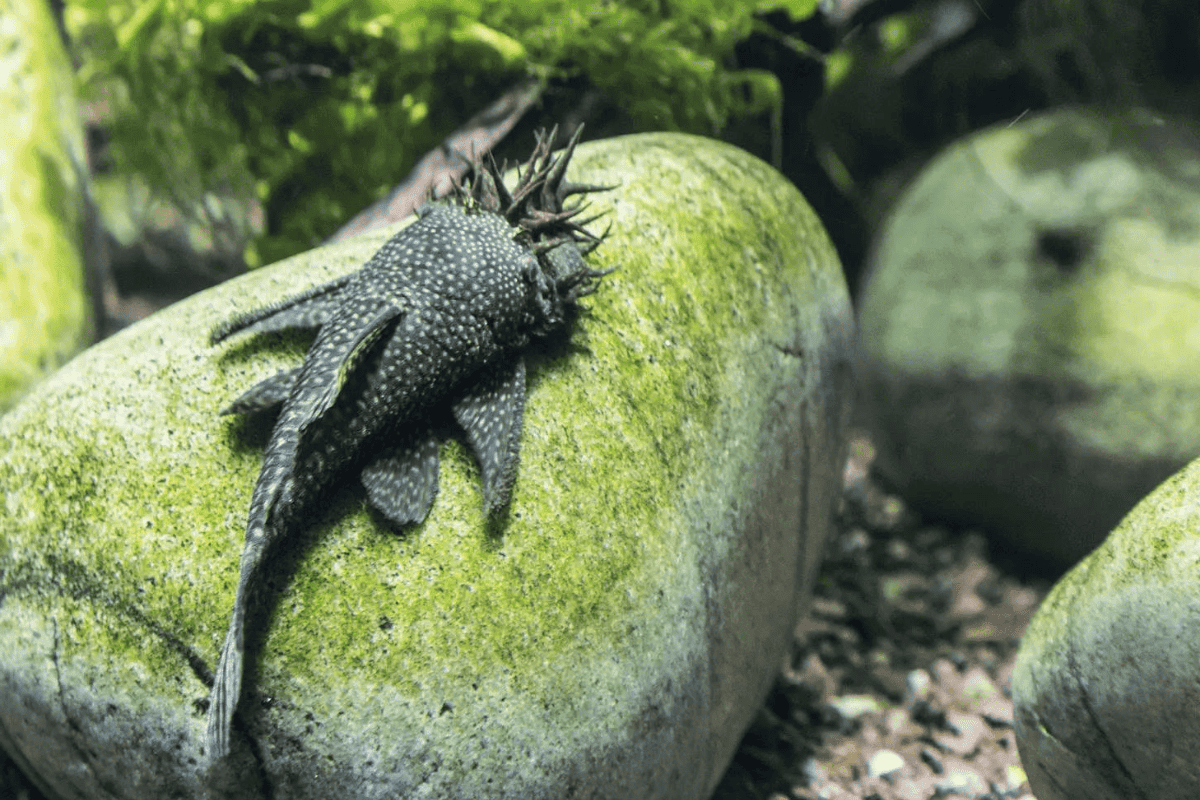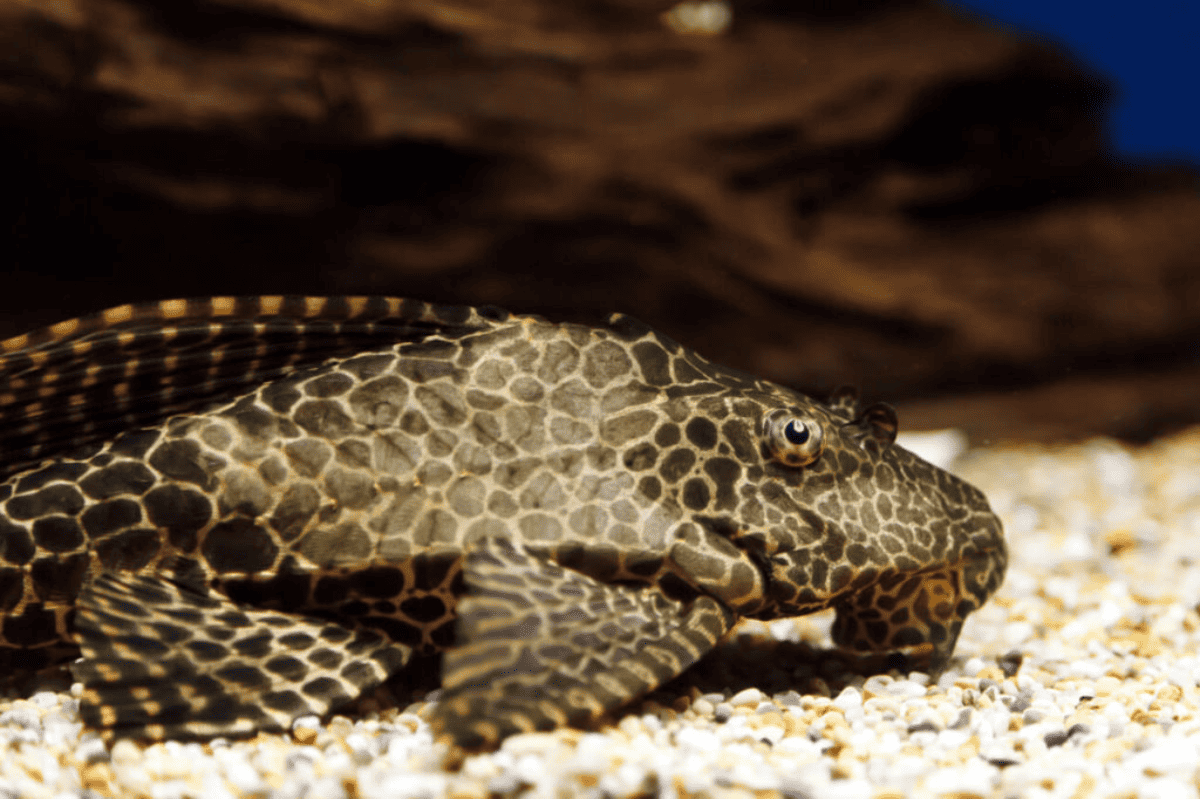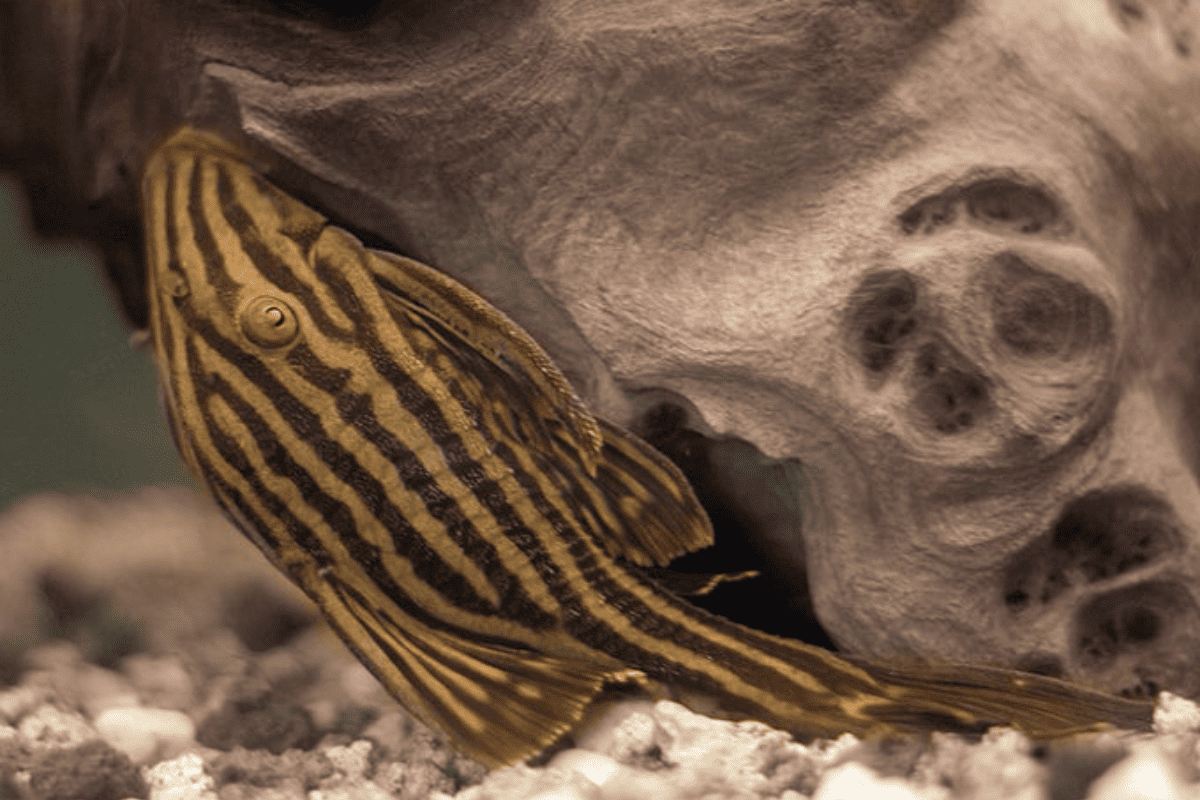Plecos are a popular consideration when thinking about species to add to a tank with flowerhorn cichlids. But is it a good idea?
Can Plecos and Flowerhorns actually share the same tank?
What about the cichlid’s aggressive nature? And if you do choose to introduce a Pleco, which species should you select?
In this article, I’ll answer all these questions and more, so you leave with all the information you need. Let’s get started.

Can I Keep Plecos and Flowerhorn Cichlids Together in the Same Tank?
No, Plecos and Flowerhorn Cichlids should not be kept together in the same tank. This combination poses risks to both species due to various factors.
- Aggressive Nature: Flowerhorn Cichlids are known for their territorial and aggressive behavior, which can lead to them attacking Plecos.
- Different Needs: Plecos often require driftwood for their dietary needs and hiding spots; however, such additions can disrupt the open space preferred by Flowerhorns.
- Size Discrepancy: Some Plecos can grow significantly large, nearing 24 inches in length, which would lead to space and territory disputes in a confined tank environment.
- Stress Factors: Plecos, being nocturnal, can get stressed by the day-time active Flowerhorn, causing them health issues and reduced life expectancy.
- Dietary Differences: While Plecos are predominantly herbivores with occasional protein intake, Flowerhorns require a high-protein diet; feeding time can hence become a contest, leading to nutritional imbalance.
Also Read: Pleco Fish Tank Mates
Plecos vs. Flowerhorn Cichlids: Behavior
The first factor worth considering is the Plecos’ and Flowerhorn Cichlids’ natural behavior. Here is what you should know:
Pleco Fish: Natural Behavior
Plecos are often regarded as gentle giants of the aquarium world. They are predominantly nocturnal creatures, mostly scavenging at night and keeping to themselves during the day.
- Nocturnal Activities: Plecos are more active during nighttime, scavenging the substrate and surfaces for algae and food particles.
- Timid Nature: While they can grow large, Plecos are usually shy and prefer hiding spots like caves and behind driftwood.
- Non-Aggressive: Plecos, for the most part, do not exhibit aggressive behaviors and tend to live harmoniously with tank mates that respect their space.
- Unique Sucking Behavior: They have specialized mouths that allow them to attach to surfaces, and they often ‘suck’ or ‘graze’ on algae-covered areas.

Flowerhorn Cichlids: Natural Behavior
Flowerhorn Cichlids are distinctly different from Plecos; they stand out with their vibrant looks and bold behavior. They have a tendency to mark certain sections of a tank as theirs.
- Territorial Instincts: Flowerhorns display intense aggression when they feel their marked space is threatened.
- Active and Observant: These cichlids are active during the day and can frequently be seen swimming, particularly when humans are nearby.
- Bold Personality: In contrast to the shy Plecos, Flowerhorns engage with their keepers, often tracking fingers or responding to motions.
- Highly Assertive: They don’t just guard their space, but may also confront other tank mates.

Ideal Parameters for Plecos and Flowerhorn Cichlids
When setting up a tank, the water’s parameters are vital to ensure the well-being of the fish.
Here’s a comparison between the ideal parameters for Plecos, Flowerhorn Cichlids, and a tank that houses both types:
| Parameter | Plecos | Flowerhorn Cichlids | Both Types |
| Temperature | 72-86°F (22-30°C) | 80-86°F (27-30°C) | 78-84°F (25.5-29°C) |
| pH Level | 6.5-7.5 | 6.0-8.0 | 6.5-7.8 |
| Water Hardness | 4-15 dGH | 6-20 dGH | 6-15 dGH |
Pleco Fish: Ideal Parameters
Plecos are hardy fish, but like any aquarium inhabitant, they have specific water conditions they thrive in. Ensuring these conditions are met will result in a healthy and active Pleco.
- Temperature: Plecos prefer a temperature range of 74°F to 80°F (23°C to 27°C) to replicate their tropical natural habitats.
- pH Level: A slightly acidic to neutral pH level, usually between 6.5 and 7.5, suits Plecos best.
- Water Hardness: Soft to moderately hard water, with a dH range between 4 and 20, is ideal for Plecos.

Flowerhorn Cichlids: Ideal Parameters
Flowerhorn Cichlids, as hybrid fish, are somewhat adaptable, but certain water conditions make them display their best colors and behaviors.
- Temperature: They prefer slightly warmer waters, typically between 80°F and 86°F (27°C to 30°C).
- pH Level: A neutral to slightly alkaline pH level is best for Flowerhorns, typically ranging from 7.4 to 8.0.
- Water Hardness: Moderately hard to hard water, with a dH range of 10 to 20, supports the well-being of Flowerhorn Cichlids.

Plecos vs. Flowerhorn Cichlids: Tank Setup
When considering tank setups, both Plecos and Flowerhorn Cichlids have their specific needs. Here’s how you can set up your tank to accommodate both fish species effectively:
| Setup Item | Plecos | Flowerhorn Cichlids | Both Types |
| Ammonia | 0 ppm | 0 ppm | 0 ppm |
| Nitrite | 0 ppm | 0 ppm | 0 ppm |
| Nitrate | <30 ppm | <40 ppm | <30 ppm |
| Tank Size | 55+ gallons (adults) | 75+ gallons | 150+ gallons |
| Foliage | Robust plants | Minimal plants | Sturdy plants |
| Decorations | Caves/Hideouts | Smooth rocks | Variety of both |
| Filter | Strong, low-flow filter | High-flow filter | Strong, varied flow filter |
| Heater | Yes, consistent temperature | Yes, tropical setting | Yes, mid-range setting |
| Substrate | Fine sand/gravel | Sand or small gravel | Mixed fine substrate |
| Pump | Yes, for oxygenation | Strong for water movement | Robust for both needs |
| Lighting | Moderate, not too bright | Moderate | Moderate |
Pleco Fish: Tank Setup
A suitable tank environment is crucial for Plecos, given their potential size and natural habitat preferences.
Catering to their specific requirements ensures their overall well-being and longevity.
- Ammonia Nitrite Nitrate: These parameters should be at undetectable levels, as Plecos are sensitive to sudden spikes.
- Tank Size: Given their size potential, Plecos need larger tanks; a 125-gallon tank is ideal for most adult species.
- Foliage: Plecos enjoy tanks with plenty of live plants for them to hide among and graze on.
- Decorations: Driftwood and caves are essential; Plecos require hiding spots and surfaces to graze on.
- Filter: A strong, efficient filter system is necessary due to the waste Plecos produce.
- Heater: Maintaining a steady temperature between 74°F to 80°F is crucial for Plecos.
- Substrate: A soft, sandy substrate mimics their natural habitat and prevents injuries.
- Pump: Good water circulation, using a reliable pump, helps replicate riverine conditions.
- Lighting: Moderate lighting is ideal, given Plecos’ nocturnal habits.

Flowerhorn Cichlids: Tank Setup
Flowerhorns, with their active and territorial nature, need a carefully crafted environment. An optimal setup promotes vibrant colors and reduces aggressive behaviors.
- Ammonia Nitrite Nitrate: As with most fish, these should be near zero levels to avoid stressing the Flowerhorn.
- Tank Size: A 75-gallon tank is typically the minimum size for an adult Flowerhorn due to their active swimming habits.
- Foliage: Plants are optional; Flowerhorns tend to uproot them due to their territorial nature.
- Decorations: Minimalistic setups with some large rocks and hiding spots are ideal without overcrowding.
- Filter: A high-capacity filter is required given the Flowerhorns’ messy eating habits.
- Heater: Flowerhorns thrive at temperatures between 80°F and 86°F, so a reliable heater is necessary.
- Substrate: Smooth gravel or sand is preferred, avoiding sharp edges that could injure the fish.
- Pump: Adequate water circulation ensures a well-oxygenated environment for these active fish.
- Lighting: Standard aquarium lighting is appropriate, enhancing their bright colors.

The Dietary Requirements of Plecos and Flowerhorn Cichlids
The dietary needs of Plecos and Flowerhorn Cichlids differ, but there are ways to manage feeding in a shared tank. Below is a comparison of their dietary requirements:
| Requirement | Plecos | Flowerhorn Cichlids | Both Types |
| Food Types | Algae wafers, veggies | High-quality pellets, live food | Varied diet for both |
| Quantity | Based on size & species | 2-3% of body weight daily | Adjust for both species |
| Feeding Schedule | Nightly or when less active | 2-3 times daily | Adjusted for both timings |
Pleco Fish: Ideal Dietary Requirements
Plecos have diverse dietary needs that skew more towards herbivory, but they also appreciate some protein. Proper nutrition is vital for their health and vitality.
- Food Types: Algae wafers, fresh vegetables like zucchini, and occasional protein treats like brine shrimp are great for Plecos.
- Quantity: Depending on the size, a Pleco’s food amount should be enough to consume within 2-4 hours.
- Feeding Schedule: Feeding Plecos once a day, preferably during dusk or nighttime, aligns with their nocturnal habits.

Flowerhorn Cichlids: Ideal Dietary Requirements
Flowerhorns, being cichlids, require a protein-rich diet to maintain their vibrant colors and robust health. They’re aggressive eaters, so portion control is crucial.
- Food Types: High-quality cichlid pellets, live or frozen foods like shrimp, and occasional fruits/veggies offer a balanced diet.
- Quantity: Feed an amount they can consume within 5 minutes to prevent overfeeding.
- Feeding Schedule: Feeding Flowerhorns twice a day ensures they get their nutritional needs without overeating.

Pleco Species Most Suitable for a Tank With Flowerhorn Cichlids
When considering Plecos for a tank with Flowerhorn Cichlids, certain robust and larger species might coexist better than others.
While it’s always a gamble, some Pleco species are more likely to stand their ground and not get bullied.
- Common Pleco: Largely resilient and can grow up to 24 inches, they have the potential to hold their own against a Flowerhorn.
- Royal Pleco: A stunning species with a robust body; its armored appearance and size (up to 17 inches) make it a possible tankmate.
- Sailfin Pleco: Reaching sizes of up to 20 inches, their size can be an advantage in deterring Flowerhorn aggression.
- Gibbiceps Pleco: These Plecos have a sturdy build and can grow up to 20 inches, possibly reducing the chance of confrontations.
- Vampire Pleco: While not as large (up to 10 inches), they’re armored and can sometimes be robust enough to share a space with a Flowerhorn.
Also Read: Can Plecos And Arowanas Live Together?

Which Pleco Types Shouldn’t Be Kept with Flowerhorn Cichlids?
While some Plecos might stand a chance, many are not suited for cohabitation with aggressive Flowerhorns.
Their smaller size or timid nature could make them potential targets.
- Bristlenose Pleco: Growing only up to 5-6 inches, their smaller size makes them vulnerable to Flowerhorn attacks.
- Zebra Pleco: Highly sought after and expensive, these smaller Plecos (3-4 inches) are far too delicate and shy.
- Clown Pleco: Their size, topping at 3.5-4 inches, and their peace-loving nature makes them a risky choice.
- Rubber Lip Pleco: Only reaching about 7 inches, their timid behavior and size can be problematic.
- Gold Nugget Pleco: Although beautiful, their size (around 8-10 inches) and temperament might not fare well with aggressive Flowerhorns.
How to Introduce Your Pleco to a Tank with Flowerhorn Cichlids
Introducing Plecos to a Flowerhorn tank requires a methodical approach to ensure both fish remain stress-free.
Proper steps can make the transition smoother and reduce potential conflicts.
- Acclimatize the Pleco: Float the Pleco’s bag in the tank for 45 minutes, every 15 minutes adding 10% tank water to the bag.
- Rearrange Decor: Before introducing, rearrange tank decorations, helping distract the Flowerhorn from the new arrival.
- Feed Flowerhorn First: Offer the Flowerhorn its favorite food, like high-quality cichlid pellets, 20 minutes before introducing the Pleco.
- Use a Barrier: For the first 48 hours, use a clear divider or mesh, ensuring both fish can familiarize without physical access.
- Monitor Closely: After removing the barrier, watch for aggressive behaviors, especially during the initial 3-hour period.

Tips for Keeping Plecos with Flowerhorn Cichlids
Successful cohabitation between Plecos and Flowerhorns relies on understanding their behaviors and ensuring their needs are met.
- Spacious Tank: Choose at least a 150-gallon tank, ensuring 30-40 gallons per Pleco, given their potential size.
- Multiple Hideouts: Install at least 3-4 caves or hideouts, spaced strategically, allowing Plecos to find shelter easily.
- Regular Feeding: Feed Plecos after dusk, using algae wafers and blanched veggies, ensuring Flowerhorns don’t hog their food.
- Observe Territories: Take note of where the Flowerhorn patrols, and try placing Pleco food away from those zones.
- Distract with Decor: Use tall plants and driftwood, creating visual barriers to break the line of sight between the fish. My recommendation: Dr. Moss Malaysian Driftwood (link to Amazon).
- Use Tank Dividers: If aggression spikes, reintroduce a clear divider for a week, allowing tensions to reduce.
- Consistent Check-ups: Daily 10-minute observations during feeding can help spot early signs of stress or potential confrontations.
Best Tank Mates for Plecos and Flowerhorn Cichlids
Finding the right tank mates for both Plecos and Flowerhorns can be a tricky venture.
However, there are certain species that can potentially coexist well alongside these unique fish.
- Parrot Cichlids: These hybrids, while not as aggressive as Flowerhorns, can adapt well and even form a bond with Plecos in larger tanks.
- Severum Cichlids: Their peaceful nature and sturdy size (up to 8 inches) might allow them to coexist alongside Plecos and not be a target for Flowerhorns.
- Oscar Fish: Being both large and relatively peaceful, Oscars, especially when matured, can share space with Plecos without major confrontations.
- Clown Loaches: While they prefer to be in groups, their size and speed can make them compatible tank mates for Plecos, provided there’s enough hiding spaces.
- Giant Gourami: Reaching lengths of 28 inches, their calm nature and size might allow them to coexist with Plecos and Flowerhorns, provided there’s enough space.
- Synodontis Catfish: Like Plecos, these fish are bottom dwellers with a sturdy build, often growing to 12 inches. This lets them live harmoniously with both fish types.
Also Read: Can Plecos And Discus Fish Live Together?

Conclusions
For the quick readers out there, here’s a brief summary:
- Pairing Plecos and Flowerhorn Cichlids in one tank isn’t advisable due to the Flowerhorn Cichlids’ aggressive tendencies and territorial behaviors.
- Plecos are gentle and active at night, whereas Flowerhorn Cichlids are day-active and bold, making them unsuitable as tank companions.
- The optimal tank conditions like temperature, pH, and water hardness vary between Plecos and Flowerhorn Cichlids, complicating a joint habitat.
- Feeding Plecos and Flowerhorn Cichlids together demands precise care due to their different dietary needs.
- If you’re thinking of introducing Plecos with Flowerhorn Cichlids, choosing resilient species and following the right introduction techniques are key to minimizing conflicts and stress.

